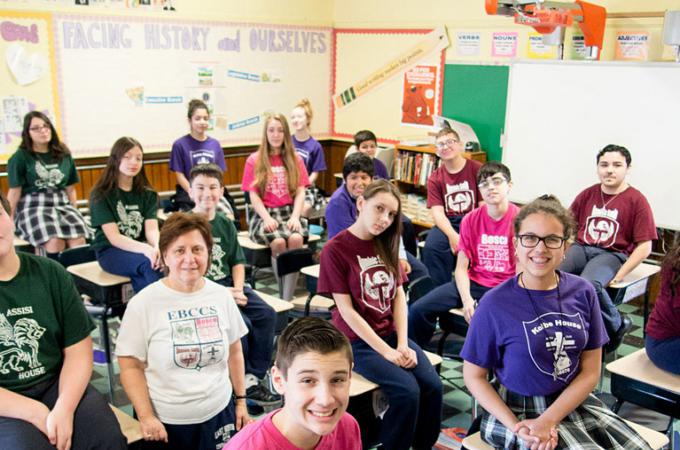Forming the Future: East Boston Central Catholic School's 'House' program
EAST BOSTON -- At the opening retreat that begins every school year, sixth graders at East Boston Central Catholic School may feel like they have stepped into the world of Harry Potter.
All their names are entered into a cauldron, and students watch as their names are chosen to belong to a "house."
"It is kind of like Hogwarts," said seventh-grade teacher Lucy Barnello, the house program founder.
"From that day on, until graduation and even beyond, the students 'belong' to one of four houses: Kolbe House, Bosco House, Assisi House and Savio House," she explained.
The House program, which was begun four years ago by Barnello "is an alternative to student council," she explained. "It gets the entire school very involved, and gives each student a sense of belonging to something unique within the school."
Barnello first heard of the idea at a National Catholic Educational Association (NCEA) conference, at which a Catholic school principal from Kansas was speaking about a similar program in his school.
"It got me very excited," she recalled. After the conference, she brought the idea to East Boston Central Catholic principal Maryann Manfredonia, who agreed to implement the program.
Rather than plan everything herself, Barnello reached out to the middle schoolers. They researched saints and ultimately decided that Sts. Maximilian Kolbe, Francis of Assisi, John Bosco and Dominic Savio were the ones they wanted to emulate.
Each house then had to pick a house color and mascot. Once these were decided upon, Barnello had t-shirts made for the students in order to represent their house. She then asked the student to create an acronym based on their mascot that would become the House motto.
"For example, the Kolbe house chose the wolf as their mascot," Barnello said, adding that their motto is "With Our Lord Forever."
Once students are assigned to a house, they are encouraged to participate in school activities in order to win points for their house.
"At the end of the year, the House with the most points wins the House Cup, and bragging rights, for the following school year," Barnello explained.
Points can also be given by teachers for a host of reasons -- for participation in school activities, for service projects, for exceptional behavior in the classroom. However, Barnello is quick to point out that "points cannot be taken away."
"We never want this to be used in a punitive way, only in a positive way," she said.
To help foster unity within the house, each month there is a "house meeting" held during school hours. These meetings are run by the House Leaders -- two students who are chosen by the faculty to lead the house.
"These are not necessarily A students," Barnello said, "but they are ones who put forth their best effort at all times."
In addition to the House Leaders, there is also a faculty member who facilitates the meeting, she said.
"I love the House program," said seventh-grader Joellemarie Monfissi, a member of the Kolbe House. "Sometimes you don't really talk to the other grades -- like the 6th grade or the 8th grade -- and this gets us all together."



















